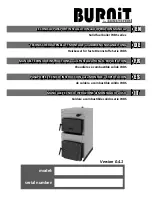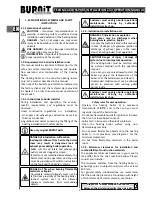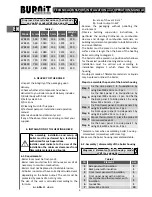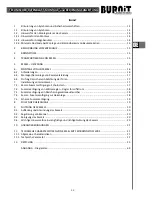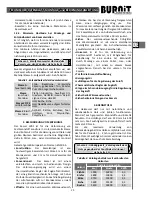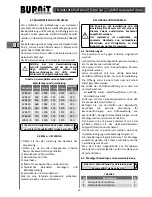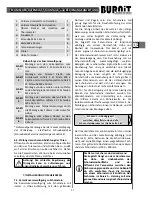
5
EN
TECHNICAL PASSPORT INSTALLATION and OPERATION MANUAL
Table 1.
Combustibility of construction materials
Class
А
– non-
combustible
Stone, bricks, ceramic tiles, baked
clay, solutions, plaster free of organic
additives.
Class
B
– hard
combustible
Gypsum board panels, basalt fiber
needled felt, fiberglass board, AKUMIN,
Izomin, Rajolit, Lignos, Velox, Heraklit.
Class С1/С2
–
Medium
combustible
Wood beech, oak
Wood softwood, layered wood
Class
C3
– easy
combustible
Asphalt, cardboard, cellulose, tar,
fiberboard,
cork,
polyurethane,
polyethylene.
2. PRODUCT DESCRIPTION
The WBS boiler is designed for firing solid fuel -
firewood, Class B wood briquettes or coal.
Designed to satisfy the heating demands of medium
to large sized spaces. They are engineered for
burning solid fuel only and provide the option for
fitting pellet, oil or gas-fired burners.
This appliance complies with EN 303-5.
•
Design.
Boiler body is made of high-quality
boiler steel sheets with thickness of 5 mm for the
combustion chamber and 3 mm for the water
mantle.
•
Conventional.
An entry-level wood firing boiler with
basic operation and low operation cost.
The combustion is controlled by thermostatic
draft regulator, which is a fully mechanical device
boasting ultimate reliability. It controls the intensity
of combustion by altering the flow of air intake.
•
Efficient
. The flue gas makes a three-pass movement
around three water-filled barriers in the combustion
chamber on its way to the chimney. This way the gas
is cool when it leaves the boiler and its energy has
been transferred to the water in the mantle. The
water mantle embraces the combustion chamber
in full to utilize the emitted heat most efficiently.
To keep from losing heat into the ambience, the
boiler is insulated on the outside by 50 mm high-
temperature wool.
•
Reliable and safe.
The heat exchanging tubular
grill is protected by a replaceable metal grate. A
complex of safety devices provide for the safety of
the appliance.
•
Versatile.
Designed for firing wood with option for
adapting to other fuel types by mounting a gas-, oil-
or pellet-fired burner on the specially designated
flange located on the lower door.
• Fuel loading door
• Cleaning door (combustion chamber)
• Air flaps for feed-in air adjustment
• Thermostatic draft regulator
• Draft regulating flap, mounted on flue end
• Safety heat exchanger
• Safety devices of the boiler
3. FUELS
The heating boiler can utilize only natural and
untreated wood, or coal. Pressed fuels and briquettes
containing only wood may also be used . Log length
should be up to 330 mm ÷ 500 mm. Fuel moisture
content must not exceed 20%.
For maximum utilization of the wood heating value
we recommend to use wood which has dried over
a period of 1,5-2 years. High moisture content of
the wood decreases its heating value which in turn
reduces boiler output.
Diagram 2. Relation between wood heating
value and water content /see page 55/
Table 2. Heating value of the most common wood
species
Wood
species
Energy contained in 1 kg
kcal
kJoule
kWh
Spruce
3900
16250
4,5
Pine
3800
15800
4,4
Birch
3750
15500
4,3
Oak
3600
15100
4,2
Beech
3450
14400
4,0
4. TRANSPORTATION OF THE BOILER
We recommend to transport the heating boiler to
the installation site in its packaging placed on the
pallet. During transport and installation, depending
on the weight, appropriate safety equipment must
be used in accordance with Directive 2006/42/EC.
When transporting items weighing more than 30 kg,
the use of pallet jack, fork truck or other hoisting
devices is a must.
The boiler body and boiler housing are pack
separately. The boiler housing has to be mount when
the boiler body is placed into the boiler room.
*
Important: When installing the boiler, the
wooden pallet onto which the boiler is
placed must be removed by unscrewing the
bolted connections using flat ring wrench
S13.
Summary of Contents for WBS 110
Page 2: ......
Page 55: ...55 1 2 3...
Page 57: ...57 6 7...
Page 58: ...58 8...
Page 59: ...59 9...
Page 60: ...60 10...
Page 61: ...61 11...
Page 62: ...62 12 13...
Page 63: ......

